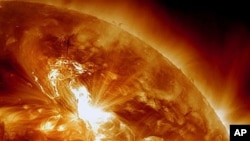The Sun’s surface erupted with a series of solar storms this week, sending a barrage of electrically charged particles crashing into the Earth’s magnetic field. So far, the solar blasts have caused only minor disruptions to terrestrial communications systems. But more solar eruptions are on the way over the next few days. The Sun is mid-way through an 11-year solar storm cycle that can have a major impact on human activities here on Earth - and in space.
Solar storms can disrupt electric power grids, triggering black-outs and false alarms at power stations, as well as interfering with high frequency radio communications.
Alex Young is a solar scientist at NASA’s Goddard Space Flight Center who studies Sun storm activity. Young scanned an official alert issued Thursday by the National Oceanographic and Atmospheric Administration [NOAA] after the first waves of solar activity reached Earth. Concerns ranged from passengers on high-flying commercial airliners to lunar orbiting satellites.
“Delta [Airlines] is taking alternate routes for seven flights. And let’s see: There was an excessive current seen in a particular satellite. And that means that some of the data was impacted and they had to put the satellite into a safe mode. This was for the GRAIL satellite,” said Young.
The twin GRAIL satellites, operated by the US Space Agency NASA, are orbiting the moon, collecting data on the lunar surface. Delta airlines flies some routes over the North Pole from the US to points in Asia because it is a shorter distance than flying closer to the Equator.
Had NASA and Delta not made these adjustments, Young said, magnetic energy from the solar storms, which is most intense at the Earth’s poles, could have seriously disrupted radio communication and caused serious damage to sensitive electronic circuits, especially critical to the NASA mission.
“If the precautions weren’t taken, then you’d have the chance of parts of the electronics and parts of the cameras on the spacecraft would be basically destroyed. And something like that, there’s no way you could go up and fix it,” said Young.
Young said the biggest concern during solar flare events is that they often are accompanied by massive eruptions of matter and energy into space called coronal mass ejections, or CMEs.
If the CMEs are ejected toward the Earth, they arrive like a tsunami of electromagnetically charged sub-atomic particles, traveling more than 965 kilometers per second. Young said when that energy wave strikes Earth’s magnetosphere, it disturbs this protective shield.
“And causes it to wiggle, kind of like ringing a bell, and that generates electrical currents in the upper atmosphere. This can excite particles that stream down into the atmosphere in northern latitudes and that creates the aurora borealis.”
Solar scientists can predict with great accuracy when CMEs will occur and whether they will impact Earth. What they can’t forecast, says Young, is precisely which way the solar winds will be blowing when they interact with the planet’s magnetosphere.
“If it’s oriented northward, which is the same direction as the Earth’s magnetic field, then the interaction is not particularly strong. But if it’s oriented southward, then the two are opposite, the Earth’s [magnetic field] is northward and the CMEs is southward, that actually causes a stronger interaction and releases more energy,” said Young.
Joe Kunches is a space scientist with NOAA's Space Weather Center in Boulder, Colorado. The Sun is in the middle of an 11-year solar storm cycle, and forecasters at NOAA expect more gusts of electrically charged particles visiting Earth within the next week.
Kunches notes a solar wind event occurred at the end of January.
"So, about six weeks ago, we had somewhat similar circumstances. Now it's here again. I think we're going to get used to seeing similar pulses come off the Sun over the next few years, and they may be as often as one every couple of weeks, one a month, something like that," he said.
Solar storm forecasters also say 2013 could see stronger solar wind activity before the storm cycle winds down.
News
Solar Storm Strikes Earth’s Magnetic Field Without Major Disruptions






